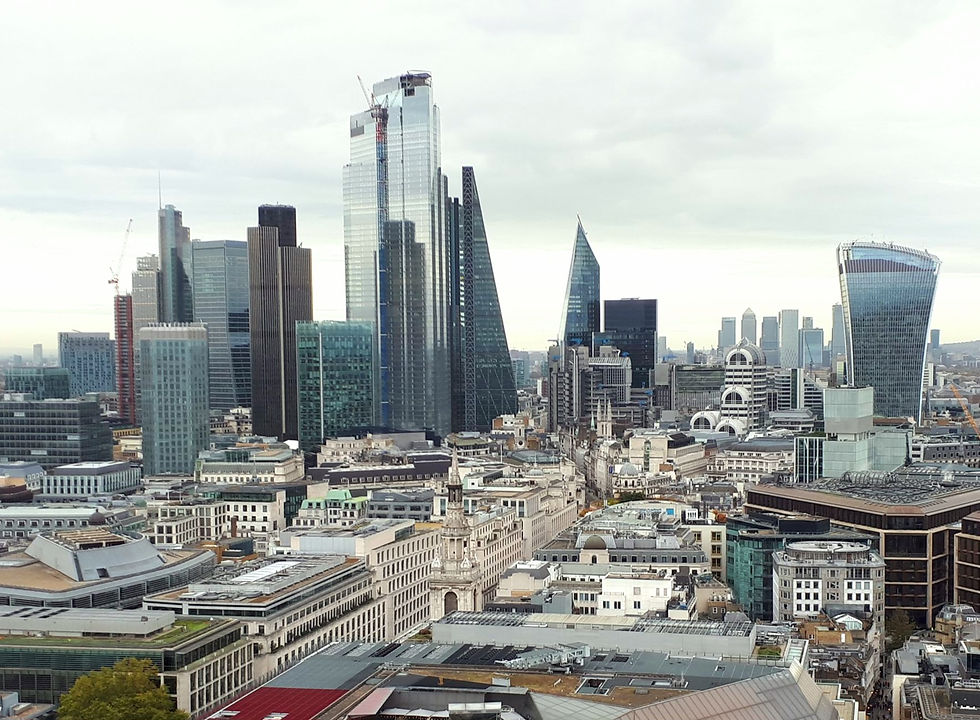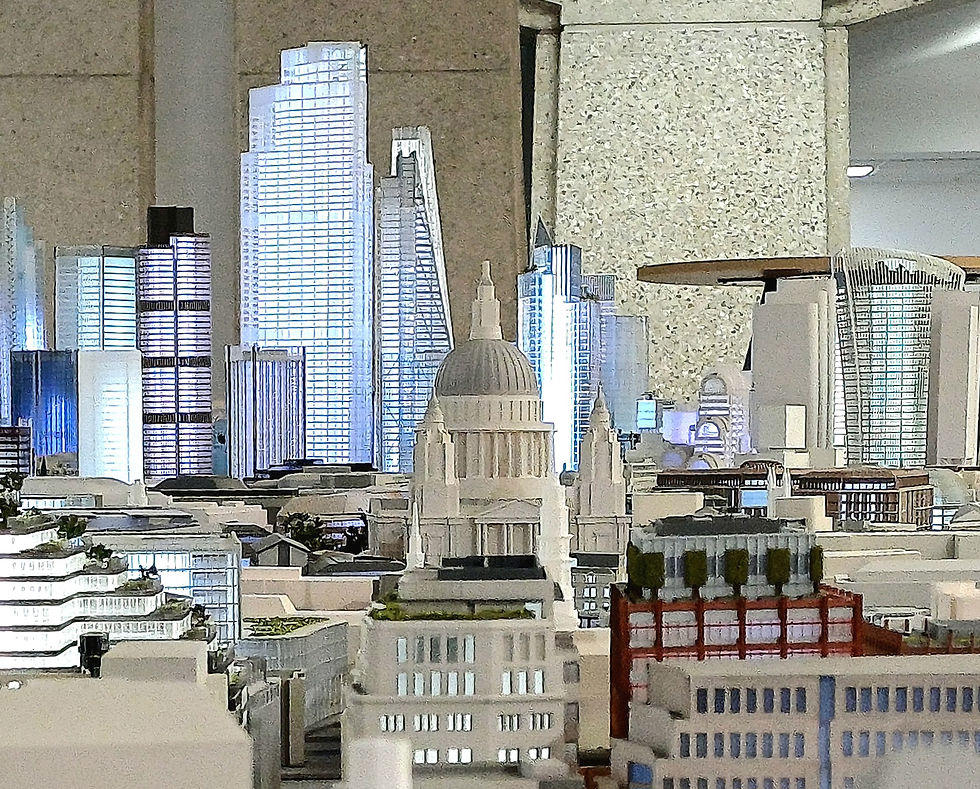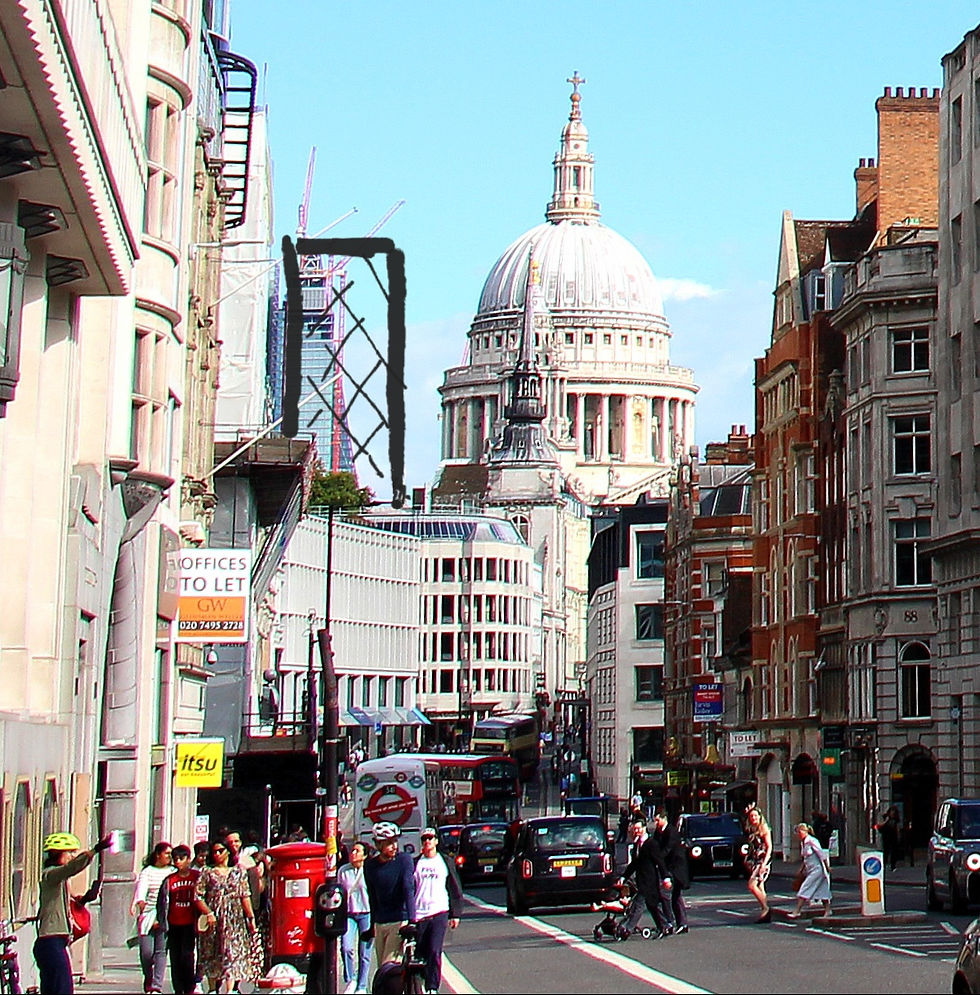How the 'Cheesegrater' got its wedge shape
- London On The Ground

- Aug 18, 2024
- 5 min read
The City of London office block, Richard Rogers and Sir Christopher Wren.

Officially 122 Leadenhall Street, or the Leadenhall Building, the 225 metre (738 ft), 48 storey building known as the Cheesegrater was designed by Rogers Stirk Harbour + Partners.

Viewed from the south and north, it presents a conventional rectangular profile (see the photo above). However, its east and west facades are a more distinctive triangular shape, pointing upwards.
Walks available for booking
For a schedule of forthcoming London On The Ground guided walks, please click here.

The Cheesegrater's steel frame, engineered by Arup, is visible through its glass exterior. The north side of the building houses the yellow-framed lift shafts and other mechanical services, which are also visible from the outside.
My video here shows the lifts in action.
Underneath the building at ground level on the Leadenhall Street side is an open atrium-like public space of 30 metres in height.

The Cheesegrater was opened in 2014 and was the last building in the City of London to be designed by Richard Rogers (1933-2021), one of the leading architects of his generation.
It stands directly across the road from Richard Rogers' first building in the City of London, the Lloyds Building, which was completed in 1986.

It was nicknamed the Cheesegrater after Rogers showed a model of the building to the City of London Corporation's planning officer, who remarked that he could imagine the architect's wife using it to grate parmesan.
At this point, you would be forgiven for thinking that this was a somewhat chauvinist comment, based on an assumption that it must be the wife that does the cooking. However, Richard Rogers was married to a chef, Ruth Rogers, who owns the Michelin starred restaurant The River Café in Hammersmith.
Strangely, the Cheesegrater owes its distinctive wedge shape - and therefore its nickname - to Sir Christopher Wren and his masterpiece, St Paul's Cathedral.
Let me explain.
Since 1938, a number of views of St Paul's from various vantage points in London have been protected under a policy known as St Paul's Heights.
Typically, the effect of this policy has been to prohibit new buildings that might obscure the view between the Cathedral and the protected vantage points
The Cathedral stands roughly three quarters of a mile west of the Cheesegrater. The skyscraper's slope is designed to clear a patch of sky for one of these protected views. You might reasonably suppose in this instance that the protected view is one towards St Paul's from the east of the Leadenhall Building.
The excellent London Centre and its detailed architectural models of the City and much of London would support you in this supposition.
My photo of the City model below shows a view from the east looking towards St Paul's. The slope of the Cheesegrater - and the almost mirror image slope of the building popularly known as the Scalpel on the opposite side of Leadenhall Street - allows a clear line of sight to the Cathedral from this viewing point in the east.

However, in real life, you would need to be hovering in a helicopter or a hot air balloon to have this view. There is no raised ground offering this view and St Paul's cannot be seen from street level. There is no viewing point to the east protected under St Paul's Heights.
The slope of the Cheesegrater is actually for the benefit of a protected view from the west. It helps to preserve the backdrop to St Paul's when seen from Fleet Street. It means that the sky behind and immediately to the side of the dome remains clear when viewed from there.
The slopes in the profiles of the Cheesegrater and the Scalpel create a V-shaped gap in the City of London's Eastern Cluster of skyscrapers, photographed here from the dome of St Paul's in 2019.

The Eastern Cluster has evolved since then. New skyscrapers have risen and still more are planned.

My photo below of the City model taken from the equivalent of roof height on Fleet Street demonstrates the gap in the skyline behind St Paul's, although, again, this is not really a view available to anyone in real life.

However, from ground level on Fleet Street, you really can see how the Cheesegrater slopes away from the dome, allowing it to be framed by clear sky to the left. Here is the view from Fleet Street at the corner with Fetter Lane.

In the photo above, another tower block appears just in front of the Cheesegrater. This is called 8 Bishopsgate and it was opened in 2023 immediately west of the Richard Rogers building. It also preserves the open sky behind the dome of St Paul's, but by rising in steps rather than by sloping away.
A better view of 8 Bishopsgate can be seen in the next photo (taken from Cornhill just outside the Royal Exchange). This shows both the steps and the modest rotations in its profile. Designed by WilkinsonEyre, 8 Bishopsgate has occasionally been dubbed The Jenga because of its shape.

The Cheesegrater is just visible behind and to the right of 8 Bishopsgate in the photo above. To the left and rising above the other two buildings is 22 Bishopsgate. From afar, these three buildings almost appear to be one.
Opened in 2020 and designed by PLP Architecture under lead architect Karen Cook, 22 Bishopsgate is the tallest building in the City of London and the second tallest in the UK (after The Shard in Southwark). So far, it has not attracted a nickname.
From another vantage point on Fleet Street, further east from the corner with Fetter Lane and closer to the Cathedral, the whole dome is visible from ground level, with the spire of St Martin Ludgate in front of it. My photo below (apologies for the poor resolution), taken while 8 Bishopsgate was still under construction, better demonstrates the clear sky that frames the dome on both sides from this part of Fleet Street.

Future buildings near the Cheesegrater will also defer to Wren's masterpiece in a similar manner. The model of the City at the London Centre includes buildings that have yet to be built, but which have planning permission.
The tallest building planned for London, 1 Undershaft, is expected to be built immediately east of the Cheesegrater. It will also slope away to the left (as viewed from the west).
Without the slope of the Cheesegrater (or the stepped profile of 8 Bishopsgate), the patch of sky to the left of the dome of St Paul's would be severely reduced. I have attempted to draw what this might look like from Fleet Street.

The Cheesegrater has only half the office space that its footprint could have provided if it rose vertically on all its facades.
However, its tapered profile is not only better for the view of St Paul's from Fleet Street, but it also gives the Cheesegrater itself a more interesting appearance.
Walks available for booking
For a schedule of forthcoming London On The Ground guided walks, please click here.




Comments